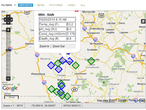WIRED DANGER ROOM
By Noah Shachtman July 28, 2010 |Categories: Spies, Secrecy and Surveillance
The investment arms of the CIA and Google are both backing a company that monitors the web in real time — and says it uses that information to predict the future.
The company is called Recorded Future, and it scours tens of thousands of websites, blogs and Twitter accounts to find the relationships between people, organizations, actions and incidents — both present and still-to-come. In a white paper, the company says its temporal analytics engine “goes beyond search” by “looking at the ‘invisible links’ between documents that talk about the same, or related, entities and events.”
The idea is to figure out for each incident who was involved, where it happened and when it might go down. Recorded Future then plots that chatter, showing online “momentum” for any given event.
Recorded Future strips from web pages the people, places and activities they mention. The company examines when and where these events happened (“spatial and temporal analysis”) and the tone of the document (“sentiment analysis”). Then it applies some artificial-intelligence algorithms to tease out connections between the players. Recorded Future maintains an index with more than 100 million events, hosted on Amazon.com servers. The analysis, however, is on the living web.
FULL STORY ONLINE
Phi Beta Iota: Both CIA and Google (as well as DoD/USDI) are treating OSINT as a technical processing problem. They will fail for lack of focus on human intelligence–all humans, all minds, all the time; and for lack of respect of the four quadrants cubed (knowledge, new craft, spivak). When they can overcome the web of fragmented knowledge, and get a grip on all information in all languages all the time (the information cube), we will be impressed. Right now, Google is nowhere near getting a grip on everything digital, let alone analog or unpublished.





